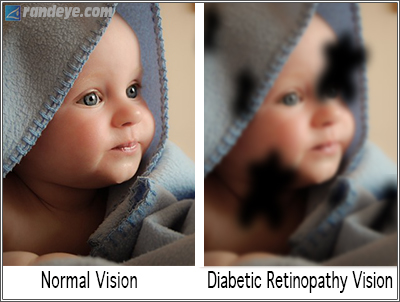Diabetic Eye Disease Month – Stay on T.R.A.C.K.
November is Diabetic Eye Disease Month, a good time to update your Rand EYE-Q.
If you have diabetes, you should know that it can affect the retina, when that occurs the result is Diabetic Retinopathy, the number one cause of blindness in the world. Even patients with well-controlled diabetes can develop diabetic changes in their retina over the years.
Here are some common signs and symptoms of diabetic retinopathy:
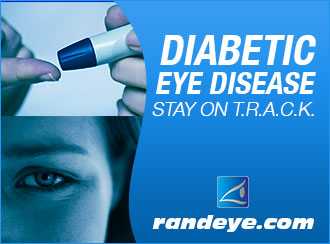
- Transient blurred vision, often linked to blood sugar level fluctuation
- Floaters and flashes of light
- Gradual or sudden loss of vision or blind spots in the vision
Over time, diabetes can affect the circulatory system of the retina. In this phase, the arteries in the retina become weakened and leak, forming small dot-like hemorrhages. If the disease progresses, leaking vessels can lead to swelling (edema) in the retina and decreased vision.
There is treatment depending upon the stage of the disease and the specific problem that requires attention. Prevention comes about when those with diabetes are able to maintain “normal” blood sugar levels more often. Diet and exercise play important roles in the overall health of those with diabetes.
Diabetics should continue this discussion with their ophthalmologist. Schedule regular eye examinations and learn their options. More than 26 million children and adults in the U.S. alone are affected by diabetes but it doesn’t have to be vision changing. Follow some simple suggestions:
Stay on T.R.A.C.K. with your diabetes by:
- Taking your medications.
- Reaching and maintaining a healthy weight.
- Adding physical activity to your daily routine.
- Controlling your blood sugar, blood pressure, and cholesterol.
- Kicking the smoking habit.
Schedule a comprehensive eye exam at Rand Eye Institute to stay ahead of vision problems.
Diabetic Eye Disease Month – Hemoglobin A1C Test
It’s Diabetic Eye Disease Month and Rand Eye is LOOKING out for you. DYK that diabetes is one of the leading causes of irreversible blindness in the United States and the most common cause of blindness in people younger than age 65?
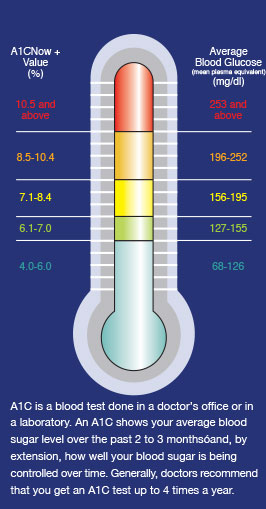
It doesn’t have to be that way if you know your Rand EYE-Q. There is a test commonly known as “A Report Card for Diabetes Control” called The Hemoglobin A1C Test, an important test that measures your blood sugar intake levels providing your true average.
The Hemoglobin A1C Test can tell you just how well you’re controlling your diabetes. By keeping your diabetes under tight control, you can significantly reduce the risk of losing your vision to diabetic eye disease. Think of the hemoglobin A1C test as if it were averaging all of your blood sugar readings from the previous three months. You should have the test three to four times a year so that you can monitor and modify your diabetes management plan.
Your Hemoglobin A1C Test reading should be 7.0 or less. Hemoglobin A1C readings above 8.0 are not as good. When the readings are 9.0-12.0 or above, the risk and severity of diabetic complications increases proportionately.
Don’t become a statistic. The American Diabetes Association estimates that 86-million people in the U.S. have pre-diabetes and 9 out of 10 of them don’t even know they have it. Without working to prevent it, 15-30% of will develop type-2 diabetes within a year, which could lead to permanent vision loss. Diabetes can also increase the risk of cataracts and glaucoma, so do your best to feel your best. In our next blog, we’ll share the facts on diabetic retinopathy. #RandEYE-Q #diabetes #diabetesawarenessmonth
National Diabetic Eye Disease Month: Know Your EYE-Q
November is designated as Diabetic Eye Disease Month and if you have diabetes or are newly diagnosed; know that you’re at risk of vision loss. What is the cause and who is most at-risk? Let’s take a look at these important facts and outline ways for you to keep from becoming a statistic.
Diabetes Could Lead to Vision Loss
Diabetes is a disease that affects blood vessels throughout the body. Unfortunately, diabetic damage in the eye, also known as diabetic retinopathy, leads to vision loss when these blood vessels leak fluid or bleed. There is laser treatment that can help control the swelling or growth of abnormal blood vessels, and another treatment that involves injections either in or around the eye. It is recommended that you see your eye care specialist to help you decide which treatment is right for you.
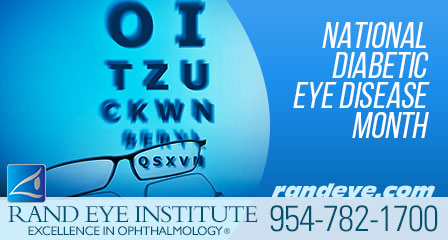
Who is most at risk?
African Americans, Native Americans, Alaska Natives, Hispanic/Latinos and older adults with diabetes are at an especially higher risk of developing diabetic eye disease.
How will EYE know?
Be proactive when it comes to your vision by scheduling a comprehensive dilated eye exam, performed by an ophthalmologist at least once or year. Early detection and timely treatment are extremely important in preventing vision loss to those highly at risk. Diet and exercise also play an important role in the overall health of those with diabetes.
Beat Diabetes by Doing This
If you are diabetic, be sure to monitor and control your blood sugar, it’s the most effective way to avoid damage and loss of vision as well as damage to the rest of your body. A hemoglobin A1C test will assist you and your physician in keeping a report card on your blood sugar control. Read more about this in our next blog.
Diabetes Can Cause Vision Problems
People who do have diabetes have a higher risk for blindness than people without it.
Some of these vision problems include: 
Glaucoma
People with diabetes are 40% more likely to suffer from glaucoma than people without it. The longer someone has diabetes, the more common it is. Risk also increases with age.
Cataracts
Many people without diabetes get cataracts, but people with it are 60% more likely to develop them. People with diabetes also tend to get cataracts at a much younger age and have them progress faster. With cataracts the eyes clear lens cloud up and block light.
Retinopathy
Diabetic retinopathy is a term used for all disorders caused by diabetes. There are two major types of retinopathy: non-proliferative and proliferated.
Non-proliferative Retinopathy: Is the most common type of retinopathy. This occurs when capillaries in the back of the eye balloon up and form pouches. Non-proliferated retinopathy can move through three stages (mild, moderate and severe) as more blood vessels become blocked.
Proliferative: In this form, the blood vessels are so damaged they close off and new vessels start growing in the retina. These new vessels are very weak and can leak blood, blocking vision. The new blood vessels can also cause scar tissue to grow. After the scar tissue shrinks, it can distort the retina or pull it out of place.
If you notice any changes in your vision, an appointment with your eye doctor should be scheduled, immediately.
Diabetic Retinopathy – Most Common Complication of Diabetes
Diabetic retinopathy is the most common complication of diabetes that affects the eyes and affects over 5.3 million Americans, 18 years old or older.
At first, diabetic retinopathy may cause no symptoms or only slight vision problems, however, eventually, it can result in blindness. 
Diabetic retinopathy can develop in anyone who has type 1 or type 2 diabetes. The longer that one has diabetes and the less controlled their blood sugar is, the higher they are at risk.
Patients with diabetes can prevent or slow the progress of diabetic retinopathy by taking prescribed medication to help maintain a healthy diet, exercising regularly, controlling high blood pressure and abnormal blood cholesterol levels, and avoiding alcohol and smoking.
If the disease does develop, significant vision loss can be avoided by monitoring aggressive blood sugar, pressure and cholesterol control. In addition, newer medications for retinopathy have recently been shown to be very effective for preserving, and sometimes improving vision.
There are several factors that can influences someone with diabetes to develop diabetic retinopathy. These include poor blood sugar, blood pressure and blood lipid control, the length of time they’ve had diabetes, race and family history.
African Americans and Hispanics are twice as likely to have diabetes.
If you have diabetes, see your eye doctor for a yearly-dilated eye exam — even if your vision seems fine — because it’s important to detect diabetic retinopathy in the early stages.
Diabetes – Leading Cause of Blindness for Americans
Diabetes is the leading cause of blindness for Americans.
According to the American Academy of Ophthalmology, 2,500 Americans become blind from complications of diabetes. About half of the nation’s estimated 16 million people show at least some signs of early diabetic retinopathy.
In diabetic retinopathy, blood vessels swell and begin to leak fluid into the retina. In some cases, abnormal blood vessels grow onto the retina. These vessels can even bleed onto the tissue and cause the retina to detach.
Early symptoms of diabetes can often go undetected and vision may not be affected until the disease is more severe and even harder to treat. Some symptoms that are usually quick to detect include: 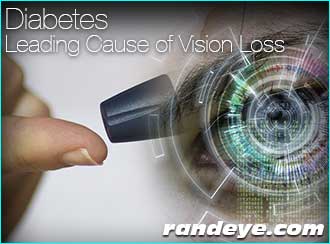
- Frequent urination
- Excessive thirst
- Weight loss/weight gain
- Increased hunger
- Tiredness
- Lack of focus
- Numbness in the hands or feet
A group of eye problems can arise due to diabetes. Cataracts and glaucoma are only a couple of vision stealing side effects. If you have diabetes you may get cataracts at a younger age, and your chances of developing glaucoma doubles.
Although many people with diabetic retinopathy do not ever progress to the most serious form of the disease, frequent testing will help your doctor monitor the patient’s condition closely.
Since most people do not develop any visual impairment until the disease has progressed considerably, delaying an eye exam until symptoms occur can result in permanent loss of vision.
Diabetic Retinopathy – Diabetes
Diabetic Retinopathy
Is the most common complication of diabetes that affects the eyes and affects over 5.3 million Americans, 18 years old or older. It is caused by damage to the blood vessels of light-sensitive tissue at the back of the eye.
At first, diabetic retinopathy may cause no symptoms or only slight vision problems, however, eventually, it can result in blindness. Diabetic retinopathy can develop in anyone who has type 1 or type 2 diabetes. The longer a person has diabetes and the less controlled their blood sugar is, the higher at risk they are.
Symptoms include:
- Floaters
- Fluctuating vision
- Dark or empty areas in your vision
- Vision loss
- Difficulty with color perception
Patients with diabetes prevent or slow the development of diabetic retinopathy by taking prescribed medication as directed maintaining a healthy diet, exercising regularly, controlling high blood pressure and abnormal blood cholesterol levels, and avoiding alcohol and smoking. If the disease does develop, the potential for significant vision loss can be reduced by more aggressive blood sugar, pressure and cholesterol control. In addition, newer medications for retinopathy have recently been shown to be very effective for preserving, and sometimes improving vision.
There are several factors that can influence someone with diabetes to develop diabetic retinopathy. These include poor blood sugar, blood pressure and blood lipid control, the length of time they’ve had diabetes, race and family history. African Americans and Hispanics are twice as likely to have diabetes.
If you have diabetes, see your eye doctor for a yearly-dilated eye exam — even if your vision seems fine — because it’s important to detect diabetic retinopathy in the early stages.

